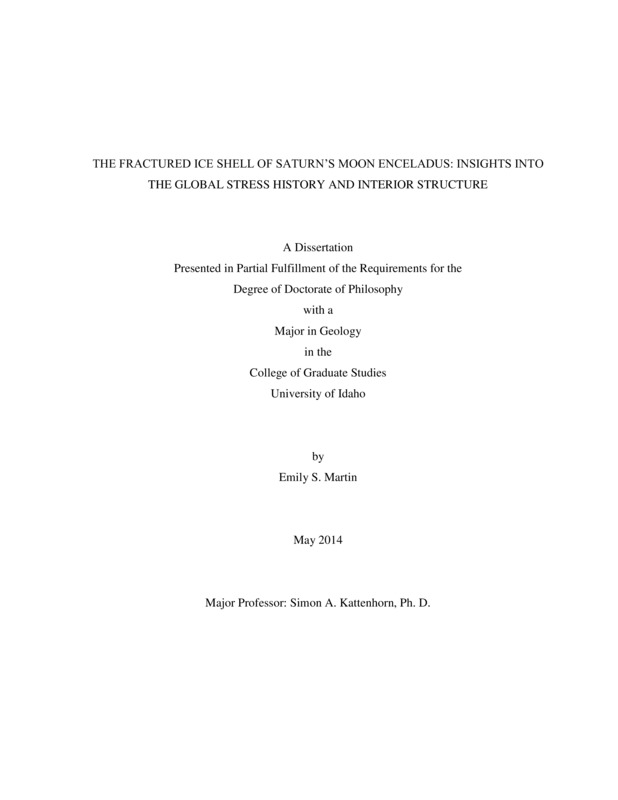The fractured ice shell of Saturn's moon Enceladus: Insights into the global stress history and interior structure
Martin, Emily Sarah. (2014). The fractured ice shell of Saturn's moon Enceladus: Insights into the global stress history and interior structure. Theses and Dissertations Collection, University of Idaho Library Digital Collections. https://www.lib.uidaho.edu/digital/etd/items/martin_idaho_0089e_10242.html
- Title:
- The fractured ice shell of Saturn's moon Enceladus: Insights into the global stress history and interior structure
- Author:
- Martin, Emily Sarah
- Date:
- 2014
- Program:
- Geology
- Subject Category:
- Planetology; Geology
- Abstract:
-
The warm south polar terrain (SPT) and associated plume activity make Enceladus an exciting target for astrobiological research. Previous work on Enceladus has focused almost exclusively on the geologically active SPT, however, to understand the Enceladus system as a whole, a complete history of the geologic processes that have shaped Enceladus through time must be resolved. With this work, I look at the global stress history on Enceladus by focusing on the recent tectonic dissection of the cratered terrains by features called pit chains. I assess the global distribution of pit chains and find that they fall into 7 unique sets with distinct orientations consistent with sequential formation in an nonsynchronous rotation stress field which implies a global liquid ocean rather than a regional south polar sea. I present a new mechanism for the unique way in which craters and pit chains interact on Enceladus by modeling additional heat generated from an impact event in a thermally unstable ice shell creating a localized zone of rising warm ice beneath a crater. Results suggest that it is the relative amounts of differential stress and fluid pressure that dictates crater-fracture interactions. I show that pit chains are among the youngest tectonic features on Enceladus's surface and that they can be used to directly infer regolith thickness across these terrains. The distribution pit depths (inferred from pit diameter and slope angles) indicate a heterogeneous distribution of regolith thicknesses across the surface. Finally we use secondary fractures, tailcracks and en echelon cracks, to identify strike-slip faults on Enceladus, and produce the first ever global map of strike-slip fault distributions on Enceladus. Additionally find that strike-slip faults fall into three classes: tectonic domain boundaries, reactivated linear features, and primary strike-slip faults. Their distributions and sense of slip are inconsistent with having formed due to a nonsynchronous rotation stress field which has been previously attributed to the formation of fracture patterns within the south polar terrain and pit chains in the cratered terrains. This result reveals that additional mechanisms are driving fracture formation on the surface of Enceladus.
- Description:
- doctoral, Ph.D., Geology -- University of Idaho - College of Graduate Studies, 2014
- Major Professor:
- Kattenhorn, Simon A
- Committee:
- Baker, Leslie L; Barnes, Gwen D; Fairley, Jerry P
- Defense Date:
- 2014
- Identifier:
- Martin_idaho_0089E_10242
- Type:
- Text
- Format Original:
- Format:
- application/pdf
- Rights:
- In Copyright - Educational Use Permitted. For more information, please contact University of Idaho Library Special Collections and Archives Department at libspec@uidaho.edu.
- Standardized Rights:
- http://rightsstatements.org/vocab/InC-EDU/1.0/

